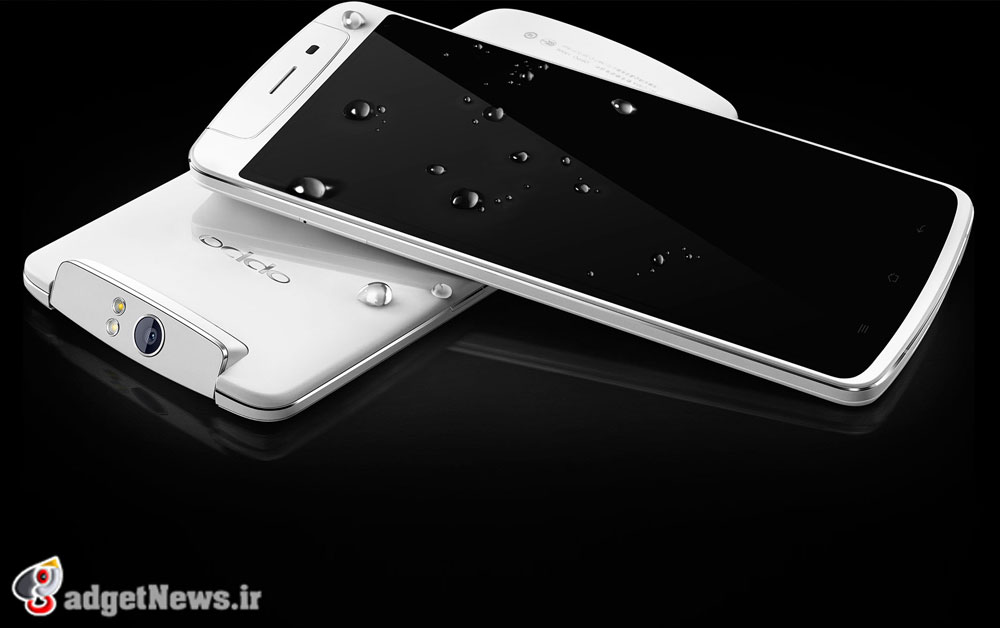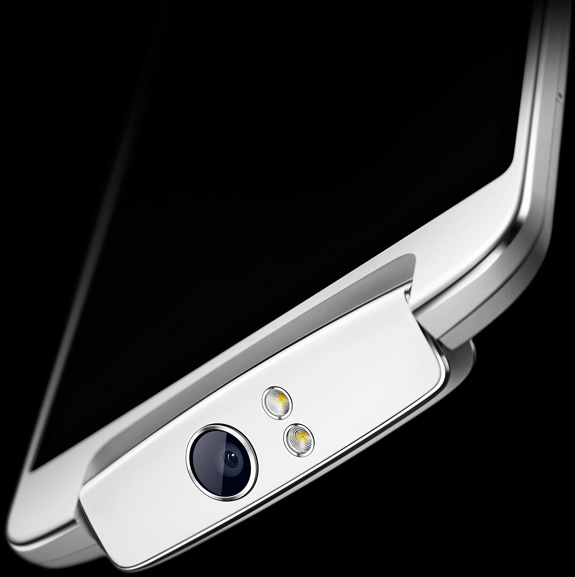
مدتی است که شایعات پیرامون پرچمدار جدید Oppo N1 به گوش میرسد و بالاخره امروز این تلفن بصورت رسمی رونمایی شد. مهمترین قابلیت N1 مربوط به دوربین چرخشی و با کیفیت آن به همراه قابلیتهای مختلف عکاسی است.
 Oppo N1 مجهز به دوربین 13 مگاپیکسلی با قابلیت چرخش 206 درجه است. به این ترتیب این دوربین میتواند نقش دوربین جلو و عقب را ایفا کند و کاربر علاوه بر مکالمه تصویری با کیفیت، امکان عکس برداری پرتره را نیز به راحتی تجربه خواهد کرد.
Oppo N1 مجهز به دوربین 13 مگاپیکسلی با قابلیت چرخش 206 درجه است. به این ترتیب این دوربین میتواند نقش دوربین جلو و عقب را ایفا کند و کاربر علاوه بر مکالمه تصویری با کیفیت، امکان عکس برداری پرتره را نیز به راحتی تجربه خواهد کرد.
این دوربین مجهز به سنسور CMOS داخلی است و لنز آن از F/2.0 پشتیبانی میکند. همچنین یک تراشه اختصاصی که توسط فوجیتسو طراحی شده، وظیفه پردازش تصویر را برعهده دارد. دوربین N1 امکان اتصال افزونه کوچک برروی لنز را نیز دارد که امکان بزرگنمایی 10 تا 15 برابر را در این تلفن میسر میکند.
قابلیت خاص دیگر N1، پنل لمسی پشت تلفن است، از نظر ظاهری به نظر میرسد که شما بدنه پلاستیکی را لمس میکنید، اما در واقعیت شما میتوانید با کشیدن دست به سمت بالا یا پایین بین بخشهای مختلف سیستم عامل اسکرول کنید یا در مروگر وب یا کتابی که در حال مشاهده آن هستید، به سمت بالا یا پایین حرکت کنید. پیش از Oppo، سونی نیز از قابلیتی مشابه در کنسول بازی PS Vita بهره برده بود.
صفحه نمایش 5.9 اینچ، N1 باعث شده تا این تلفن در شاخه فبلتها جای گیرد. این تلفن 213 گرم وزن دارد و صفحه نمایش IPS LCD آن از رزولوشن 1920 در 1080 پیکسل پشتیبانی میکند.
{photo}92/07/02/Oppo-N1{/photo}
N1 مجهز به سیستم عامل اندروید 4.2 به همراه رابط کاربری خاص Oppo به نام Color OS است. از دیگر مشخصات سخت افزاری N1 میتوان به پردازنده Snapdragon 600 با چهار هسته 1.7 گیگاهرتزی، حافظه رم 2 گیگابایت و باتری 3610 میلی آمپرساعتی اشاره کرد.
قیمت N1 حدود 570 دلار تعیین شده و قرار است از ماه آینده روانه بازار شود.
منابع : engadget | phonearena
Oppo N1 goes official: rotating camera, touch panel on back, release date in October, flagship price
The long teased Oppo N1 has just been uncovered and it’s a strange device – a large and thin 5.9-inch Android smartphone with a rotating camera and a touch panel on the back of the handset for easier single-handed operation.
Rotating camera and back touch panel
The big focus is of course on camera. The Oppo N1 features a 13-megapixel camera that you can rotate 206 degrees so it can serve as both a rear and front facing snapper. There’s a CMOS sensor inside and a wide f/2.0 aperture. It is powered by a dedicated and specially designed Fujitsu imaging chip. The camera also supports small plug-in lenses enabling zoom levels of up to 10 times and 15 times.
Next, there is a unique touch panel on the back. It does not stand out in any way – it looks as if you are simply touching the plastic on the back with your fingers. In reality, you can simply slide your finger up or down the back touch panel to navigate around in menus and the web browser.
5.9" display in a true phablet
The Oppo N1 is a large phone and fairly thin plastic device coming in black and white. If we had to compare it to a well known device, that would be the Galaxy Note series of phablets, but the N1 is even larger and wider. It also weighs heavier at 213 grams, or 0.47 pounds.
It features a 5.9-inch 1080 x 1920 pixel full HD IPS display that is very sharp. Pixel density stands at 377ppi, way above the ‘Retina’ threshold.
Software-wise, we’re looking at Android 4.2 with Color OS, a custom skin made by Oppo. The N1 should also be able to run stock Android thanks to Cyanogenmod.
Under the hood, the Oppo N1 runs on a quad-core Snapdragon 600 chip running at 1.7GHz. There’s Adreno 320 graphics and 2GB of RAM on board. The presence of a whopping 3610mAh battery is definitely reassuring.
In terms of connectivity, the N1 supports all standards like dual-band Wi-Fi 802.11ac, Bluetooth 4.0 and NFC.
The Oppo N1 price is set pretty steep at nearly 3500 yuan, or the equivalent of $570 off contract. The release date for the Oppo N1 is set somewhere in October, but pre-orders are already available in China. The phone is not expected to be immediately available internationally – it’s mostly targeting the world’s biggest Chinese market.
 گجت نیوز آخرین اخبار تکنولوژی، علم و خودرو
گجت نیوز آخرین اخبار تکنولوژی، علم و خودرو 





